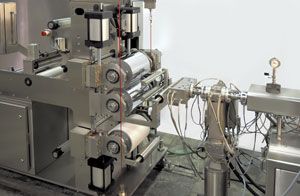Twin-Screw Extruders Serve the Pharma Industry
Equipment and Processing Report
At an industry seminar hosted by Leistritz Extrusion, experts explained the use of extrusion equipment to mix polymeric excipients with APIs for solubility enhancement and for multifunctional and specialty dosage forms, including implants.
Twin-screw extruders, long used by the plastics industry for continuous mixing of polymer compounds, are now also well established as continuous mixing equipment for polymeric excipients and APIs. GMP materials of construction, easily cleanable designs, and equipment for contained feeding of high potency ingredients are all commercially available. Pharmaceutical applications for twin-screw extrusion, as well as practical information for setup, cleaning, and validation, were discussed at the Leistritz Pharmaceutical Extrusion Seminar (June 7–8, 2017, Clinton, NJ).
An important use of pharmaceutical hot-melt extrusion (HME) is the bioavailability enhancement of poorly-water soluble APIs. In HME, twin-screw extruders are used to dissolve and mix the poorly water-soluble, hydrophobic APIs (typically below their melting temperature) in water-soluble, hydrophilic excipients (typically 50–100 ËC above their glass transition temperature) to create “amorphous solid solutions” that have increased bioavailability relative to their crystalline counterparts. One challenge is that the amorphous forms should remain stable (i.e., not revert to crystalline form) at ambient temperature, typically for a two-year shelf-life, noted Nicolas Ioannidis, research engineer at the Polymer Processing Institute, in a presentation at the seminar.
Twin-screw extrusion can also be used to continuously mix APIs with excipients so that the mixture can be formed into a drug delivery device, such as a contraceptive ring or an implantable rod for long-acting, controlled release and local drug delivery. Merck, for example, is investigating an implantable rod to deliver an antiretroviral HIV treatment. In oral form, repeat administration or large tablets would be required, but an implant could improve patient compliance, explained Seth Forster, scientist at Merck Research Laboratories, in a presentation at the seminar. The API-excipient mixtures for such products could be either amorphous solid dispersions or, if API solubility is not a concern, dispersions of a crystalline API in the polymer. “Extrusion is an elegant way to make a complex structure,” concluded Forster.
A laboratory-scale lamination system that can be used to develop wound care, dissolvable film, and transdermal products was demonstrated during the seminar. Image courtesy of Leistritz.

Foster Delivery Science opened a new cGMP manufacturing facility in 2015 that is dedicated to using twin-screw extrusion to make polymer blends for various drug delivery dosage forms, including drug-delivery implants, and is seeing growing use in these areas, noted Tony Listro, vice-president of Foster Delivery Science. At the seminar, he described a direct extrusion process for a drug-eluting dental implant for local drug delivery, in which the API and excipient are mixed and then formed into a monofilament, all within one process. In another example, he described how drug products mixed on a twin-screw extruder can be formed into a film for transdermal delivery.
“The evolution of twin-screw extrusion for continuous mixing applications is analog to what happened 50 years ago in the plastics and food industries,” explained Charlie Martin, president and general manager at Leistritz, which hosted the seminar. “This technology has been well proven for decades in a 24-hour-per-day industrial setting making many of the most sophisticated products we use every day. The next stage of development for pharmaceutical applications will be downsizing and applying existing extrusion technologies for multifunctional and specialty dosage forms.”
Drug Solutions Podcast: A Closer Look at mRNA in Oncology and Vaccines
April 30th 2024In this episode fo the Drug Solutions Podcast, etherna’s vice-president of Technology and Innovation, Stefaan De Koker, discusses the merits and challenges of using mRNA as the foundation for therapeutics in oncology as well as for vaccines.
